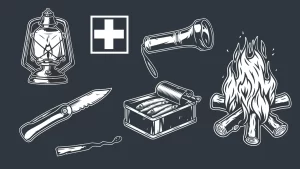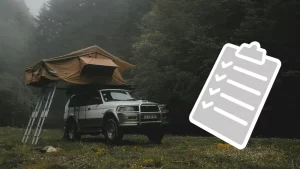…but a lack it most certainly will. You might think that durability and longevity are pretty much the same thing. But if we look at the definitions, durability refers to how well a product resists damage, and longevity refers to how long a product lasts before it needs to be replaced. So, durability is one of two key factors that determine how long a product will last before it needs replacing. The other major influencing factor is maintenance.
In this era of hype, trends, and corporate goals to maximise bottom-line results, the price of something does not always reflect its real value. If a big brand is on a roll, they can put any price on any product and it will sell. On the other hand, a small company may make a better product at a lower price because they don’t have the huge overheads. So, it’s up to you to look at all the details and features of the product you intend to buy in your search for the best overall package.
DURABILITY
If you’re looking at rooftop tents as a newcomer, then talk to friends and ask questions on groups and forums about their opinions of what they own or have owned. This is particularly important if you are buying a second-hand tent that may already have several years and thousands of kilometres under its belt.
“Put in” items are not the topic here. For example, a mattress will be chosen for the comfort it provides you as an individual, and not for how long you think it will last or how it will affect the durability of the tent. If you are looking for a tent that will give you reliable shelter for years to come and still get you a return when you decide to sell, then look at the structural integrity of the tent and the materials and parts that make up the whole.
As far as soft-shell tents are concerned, start with the outer cover. The material should resemble the material and thickness of a truck’s canopy if it is going to withstand driving under trees and enduring the elements on some of the hottest, wettest, and coldest days of the year. Materials can weather badly and become brittle or powdery—especially the top surface, which you don’t always get to see unless you actually remove the cover to use the tent. If the cover is damaged in any way and water can get inside without you noticing, then your tent is essentially ruined. It will not dry out and mould will set in.
Look at the frame that holds the tent taught and in shape. This will most likely be made from aluminium tubing, so rust won’t be an issue. But look at the joints and brackets that hold everything together and allow them to move freely. Are they solid enough to cope with typical regular use? Are the nuts and bolts holding them to the floor suitably sized for a reliable mount, or could they pull out? Are the rivets well seated and strong enough?
Hard-shell tents are generally well equipped to fend off the elements. But even so, take a good look at the strength of the material if you are contemplating carrying any equipment or solar panels up there. Aluminium can be a good alternative to synthetics and GRP.
Floors Wood is no longer the ideal material. It is heavy and can absorb moisture if not treated properly. There are various composite and synthetic honeycomb materials which are extremely strong, lightweight, and impervious to water.
Hinges Every time you open and close the tent, the hinges need to work, support the roof, and withstand the wind. Look at the hinges and the nuts and bolts that hold them in place. Are they mounted solidly? Will they hold up in a storm? Are they made of stainless steel or are they painted to hide ordinary steel that may rust at a later date? Is the material of the lid/floor thick enough or has it been reinforced at the mounting points to take up the strain of a strong wind?
Clasps and Locks When you close a hard-shell tent, the lid is always under a certain amount of tension as it compresses its contents, and the clasps that ultimately pull and hold it all together are stressed… and that is before you start driving on and off the road. Yes, there are probably some other straps to assist, but the clasps are mechanical and must endure a lot of multi-directional force over the years. Look at the materials and how they are attached to the tent itself. Can they be adjusted to take up any slack that may occur over time?
Zips I can’t stress this enough: only accept strong zips. There is nothing worse than not being able to close a window, door, skylight, or, worst case scenario, not being able to secure the cover of a soft-shell tent.
Tent The fabric that makes up the tent can be light or heavy. Ask about characteristics like ripstop and waterproofing. Examine how the seams have been sealed or taped. How is it attached to the floor and roof—can the joint tear? Check the stitching on zips, windows, and mosquito nets.
Also, look at the eyelets where, for example, spring steel rods hold up porches, or where guy lines are attached. Are they strong enough, and is the material they are pressed into reinforced? You don’t want them ripping out when the wind picks up.
Struts These take the muscle power out of lifting the roof and holding it up when you want to sleep. First of all, do they do the job of lifting smoothly and evenly? How are they mounted to the floor and lid? Do they come with restraints to prevent them closing under the pressure of a strong wind?
Ladder It doesn’t matter whether the ladder is telescopic or more traditional, it should be sturdy, the feet should be large enough to prevent sinking into the ground, the rungs should be comfortable to stand on, and the ladder in its entirety should be strong enough to support your weight. If the ladder is attached to the floor of the tent, check the mountings. After all, you will be using the ladder’s leverage to open and close tents with folding floors, so the forces exerted on the fixings will be considerable.
Roof Rack Mounting Points These need to be solid and reliable. Check how the slotted rails are mounted to the floor of the tent, and the material quality of the fasteners that clamp onto the crossbars or rack.
Supplied Storage Bags and Pouches These are often regarded as an afterthought, but when you put the spring steel rods into the pouch and they shoot out through the bottom, then you know what I mean. Are seams and vulnerable areas reinforced? Are the bags that harbour awnings and ground tents A) big enough so that you can easily stow whatever needs to go in, and B) waterproof if they have to be transported outside the vehicle?
MAINTENANCE
Rooftop tents require maintenance:
- They should never be stored damp or wet, and all the parts should be thoroughly cleaned if you are not going to use the tent for a while.
- Ask your dealer for maintenance suggestions and safe cleaning agents.
- Take a moment to give the whole tent a once-over when it is set up, especially the structural features.
- Check the tent for damage after a severe storm.
LONGEVITY
Even the best-made products deteriorate with age and regular use. Even more so if they are not serviced regularly. If you want years of stress-free camping, check the critical features and buy the product you can afford. Once it’s your’s, look after it.
A well-maintained product won’t give you any surprises at the worst possible time, and will allow you to command the best possible price if and when you want to sell.







